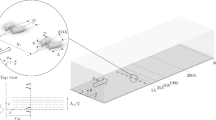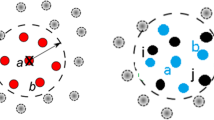Abstract
The Weakly Compressible Smoothed Particle Hydrodynamics (WCSPH) has been applied to simulate the flow through a Gravitational Vertical Turbine (GVT) configuration and the motion of the turbine of a small hydropower system. The turbine blades are assumed to be rigid bodies moving with one-degree of freedom, which is the rotation about its shaft due the hydrodynamic forces of the flow. The intake flow is an open channel flow which falls into a cylindrical basin which houses the turbine and impinges on the turbine blades. The method of simulation is the Weakly Compressible Smoothed Hydrodynamics (WCSPH) with the turbulence models in the equations of motion and the boundary conditions. The results are compared with a laboratory experiments conducted for the same dimension and the configuration. The flow features agree well and the motion of the turbine with a representative mass and a load agrees reasonably with the laboratory experiments
Similar content being viewed by others
Abbreviations
- A :
-
Constant in log-law of turbulent wall flow
- a :
-
Particle of which motion is calculated
- B :
-
Constant in log-law of turbulent wall flow
- b :
-
Particles near particle a
- c :
-
Particle just outside wall layer of particle a when a is within wall layer
- C D :
-
Resistance coefficient of turbine
- C T :
-
Wall shear coefficient
- D :
-
Rotational resistance of turbine
- h :
-
Smoothing length
- h b :
-
Thickness of the inflow and outflow bugger regions
- h w :
-
Wall layer thickness
- I :
-
Angular moment of inertia of turbine
- j :
-
Unit vector in y direction
- m :
-
Mass of a particle
- n :
-
Unit vector normal to solid boundary
- P :
-
Power
- p :
-
Pressure
- Q :
-
Transformation matrix for rotation about y axis
- r :
-
Position vector of a particle
- T :
-
Torque about axis of turbine rotation
- t :
-
Time
- t :
-
Unit vector tangent to solid boundary
- u τ :
-
Friction velocity associated with wall shear
- v :
-
Velocity vector
- w :
-
Particles representing solid boundary closest to particle a
- y :
-
Vertical coordinate
- ρ :
-
Density
- θ :
-
Angular position
- θ′:
-
Principal value of θ in (0, 2π)
- ω :
-
Rotational velocity
- ∇a :
-
Gradient operator with respect to coordinated of position of particle a
- a :
-
Quantity associated with particle a
- b :
-
Quantity associated with particle b
- n :
-
Component of vector normal to boundary
- t :
-
Component of vector tangent to boundary
- w :
-
Quantity associated with boundary particle w
- 0 :
-
Quantity at initial time t = 0
References
Abdul Aziz MQ, Idris, J, Abdullah MF (2022) Simulation of the conical gravitational water vortex turbine (GWVT) design in producing optimum force for energy production. Journal of Advanced Research in Fluid Mechanics and Thermal Sciences 89:99–113, DOI: https://doi.org/10.37934/arfmts.89.2.99113
Antuono M, Colagrossi A, Marrone S, Molteni D (2010) Free-surface flows solved by means of SPH scheme with numerical diffusive terms. Computer Physics Communications 181:532–549, DOI: https://doi.org/10.1016/j.cpc.2009.11.002
Asthana A, Mukherjee S (2019) Design, development, testing and evaluation of an innovative floating hydro-generator. The International Conference on Energy and Sustainable Futures (ICESF), 283–288
Dhakal S, Timilsina A, Dhakal R, Fuyal D, Bajracharya T, Pandit H, Amatya Nanakarmi A (2015) Comparison of cylindrical and conical basins with optimum position of runner: Gravitational water vortex power plant. Renewable and Sustainable Energy Reviews 48:662–669, DOI: https://doi.org/10.1016/j.rser.2015.04.030
Edirisinghe DS, Yang H-S, Gunawardane SDGSP, Lee Y-H (2022) Enhancing the performance of gravitational water vortex turbine by flow simulation analysis. Renewable Energy 194:163–180, DOI: https://doi.org/10.1016/j.renene.2022.05.053
Ferrand M, Laurence DR, Rogers BD, Violeau D, Kassiotis C (2012) Unified semi-analytic wall boundary conditions for inviscid, laminar or turbulent flows in the meshless SPH method. International Journal for Numerical Methods in Fluids 71(4):446–472, DOI: https://doi.org/10.1002/fld.3666
Lind SJ, Rogers BD, Stansby PK (2020) Review of smoothed particle hydrodynamics: Towards converged Lagrangian flow modelling. Proceedings of the Royal Society A: Mathematical, Physical and Engineering Sciences 476:20190801, DOI: https://doi.org/10.1098/rspa.2019.0801
Liu GR, Liu MB (2003) Smoothed particle hydrodynamics: A meshfree particle method. World Scientific Publishing Co., Singapore
Mokos A, Violeau D, Bercovitz Y, Sarret F, De Leffe M (2021) Modelling of the water nappe gravity fall over a dam. Proceedings of the 15th International SPHERIC Workshop June 8–11, 2021 Virtual Workshop
Monaghan JJ (1994) Simulating free surface flows with SPH. Journal of Computational Physics 110:399–406
Morris JP, Fox PJ, Zhu Y (1997) Modeling low Reynolds number incompressible flow using SPH. Journal of Computational Physics 136:214–226
Nakayama A, Kong WS, Leong LY, Ng KC (2019) Improvement of weakly compressible SPH method for turbulent free surface flows. Journal of Japan Society of Civil Engineers, Ser. B1 (Hydraulic Engineering) 75(2):I_588–I_593
Nakayama A, Lye XY, Ng KC (2022) Wall-layer boundary condition method for laminar and turbulent flows in weakly compressible SPH. European Journal of Mechanics - B/Fluids 95:276–288, DOI: https://doi.org/10.1016/j.euromechflu.2022.05.009
Paudel S, Linton N, Zanke UCE, Saenger N (2013) Experimental investigation on the effect of channel width on flexible rubber blade water wheel performance. Renewable Energy 52:1–7, DOI: https://doi.org/10.1016/j.renene.2012.10.014
Rentschler M, Marongiu JC, Neuhauser M, Parkinson E (2018) Overview of SPH-ALE applications for hydraulic turbines in ANDRITZ Hydro. Journal of Hydrodynamics 30:114–121, DOI: https://doi.org/10.1007/s42241-018-0012-y
Sun PN, Colagrossi A, Marrone S, Zhang AM (2017) The dplus-SPH model: Simple procedure for a further improvement of the SPH scheme. Computer Methods in Applied Mechanics and Engineering 315:25–49, DOI: https://doi.org/10.1016/j.cma.2016.10.028
Valizadeh A, Monaghan JJ (2015) A study of solid wall models for weakly compressible SPH. Journal of Computational Physics 300:5–19, DOI: https://doi.org/10.1016/j.jcp.2015.07.033
Violeau D, Rogers BD (2016) Smoothed particle hydrodynamics (SPH) for free-surface flows: Past, present and future. Journal of Hydraulic Research 54(1):1–26, DOI: https://doi.org/10.1080/00221686.2015.1119209
Wanchat S, Suntivarakorn R, Wanchat S, Tonmit K, Kayanyiem P, Wanchat S, Suntivarakorn R, Wanchat S, Tonmit K, Kayanyiem P (2013) A Parametric study of a gravitation vortex power plant. Advanced Materials Research 805–806:811–817
Acknowledgments
The present work was partly supported by Malaysian Ministry of Higher Education Fundamental Research Grant System FRGS/1/2019/TK01/UTAR/01/1 and Universiti Tunku Abdul Rahman Research Fund (UTARRF/2022-C1/A03).
Author information
Authors and Affiliations
Corresponding author
Rights and permissions
About this article
Cite this article
Ng, S.K., Nakayama, A. & Ng, W.X. Application of Smoothed Particle Hydrodynamics Method for the Analysis of the Flow Past Vertical Vortex Turbine of a Micro Hydropower. KSCE J Civ Eng 28, 1132–1139 (2024). https://doi.org/10.1007/s12205-024-1732-x
Received:
Revised:
Accepted:
Published:
Issue Date:
DOI: https://doi.org/10.1007/s12205-024-1732-x




